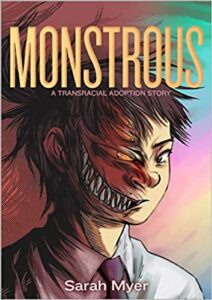Monstrous: A Transracial Adoption Story
Sarah Myer
First Second
Published June 27, 2023
Amazon | Bookshop | Goodreads
About Monstrous
A poignant young adult graphic memoir about a Korean-American girl who uses fandom and art-making to overcome racist bullying. Perfect for fans of American Born Chinese and Almost American Girl!
Sarah has always struggled to fit in. Born in South Korea and adopted at birth by a white couple, she grows up in a rural community with few Asian neighbors. People whisper in the supermarket. Classmates bully her. She has trouble containing her anger in these moments―but through it all, she has her art. She’s always been a compulsive drawer, and when she discovers anime, her hobby becomes an obsession.
Though drawing and cosplay offer her an escape, she still struggles to connect with others. And in high school, the bullies are louder and meaner. Sarah’s bubbling rage is threatening to burst.
My Review
I loved this memoir, though parts of it were heartbreaking to read. No one should be treated the way the author was. The descriptions of early childhood and particularly the difficulty of telling the difference between anxiety and having a wild imagination made so much sense to me. I think back in the 80s and 90s in particular, we didn’t talk about fear and worry in terms of mental health. It was viewed more as personal quirkiness maybe? I definitely grew up thinking that a lot of my own struggles with anxiety were simply my overactive imagination. So reading about Sarah’s experience with that was both sad and very validating.
I think what’s truly brilliant about this book is the way that Myer uses concrete visual storytelling to tell the story of a really abstract idea. Because ultimately what the book is about is the journey Sarah takes to learn self-love and peace. I love that art is such a huge part of that story– the fact that the artist is telling their own story through art adds a whole extra layer to the message, too. Because not only has Sarah learned self-love through art, they’ve also found a way to use art to share their story and welcome others into an exploration of self-love, too.
I also love the relationships in the book and the way that each character in Sarah’s family isn’t perfect, but it’s clear that there’s love between them.
This is a great book for anyone struggling with anger, anxiety, or bullying.
Content Notes
Recommended for Ages 14 up.
Representation
Sarah and her sister are Korean American, adopted by white parents.
Profanity/Crude Language Content
Extreme profanity used infrequently. Racial and homophobic slurs used infrequently.
Romance/Sexual Content
Infrequent use of homophobic slurs. Sarah wonders about a couple of past friendships and whether those were also crushes.
Spiritual Content
None.
Violent Content
Some scenes include racist comments and stereotypes. Others bully Sarah. She sometimes reacts by name-calling or hitting them.
Drug Content
References to teens drinking beer.
Note: This post contains affiliate links, which do not cost you anything to use, but which help support this blog. I received a free copy of MONSTROUS in exchange for my honest review.
